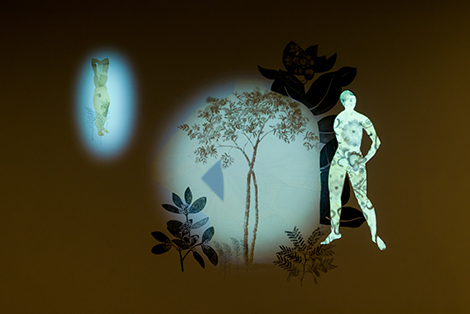Nostalgia for the raw flow of dreams suffuses Stas Orlovski’s hypnotic installation, “Chimera,” activating a longing for the power of imagination as dreams coalesce into interpretation and noetic concerns. Orlovski conjures a fantastic synthesis from diverse parts: wall drawing, animated projections and sound composed by artist Steve Roden.
Over Orlovski’s wall-drawn images of delicate flowers, the oval shape of a hand-held mirror and two silhouetted figures, projected images waft along—transitioning from flocks of birds to torn pieces of paper, from slowly traced lines to abstract wisps of liquid paint. Movements within Orlovski’s animated projection are real and suggested, with the luminous beam now expanding to cover the whole wall, then contracting to focus on a single image.
Puddles of water expand in the marks of outwardly rippling concentric circles where the rain has hit the flat surface and leaves from spindly plants tremble in the wind. Orlovski creates an unavoidable sense of longing for an idyllic world where childhood reveries are undisturbed by ordinary events. The sound piece composed and executed by Steve Roden that accompanies this installation is in turn poignant and melancholy, transporting the viewer to a place where reason and linear sequences have little sway. Roden’s sonic contribution echoes the overall thrust of Orlovski’s practice.
Culling images from Soviet-era children’s books, Victorian, Japanese and Chinese fragments and botanical book illustrations, Orlovski fashions these disparate pieces into a space of projected light where the divergent histories and images meld kaleidoscopically. Meant as an extension of his painting and drawing practices and motivated by the desire to simulate the turning pages of a book, collapse a three-dimensional entity, create alternating weather conditions or turn a moonbeam on and off, Orlovski has set up an iconography of light, waterways, gardens, birds, butterflies and flowers. This is all done in the near-monochromatic earth tones that this artist typically employs.
This delicate Kino show and its mixture of lit-up wall drawings, sequentially built-up collages, stop-motion animated constructions and overlaid sound harkens back to the quasi-projections of 18th- and 19th-century Phantasmagoria shows, but in Orlovski and Roden’s reinterpretation, enchantment is not the only impetus. Rather, a distinctly anti-modern appeal to direct sensory appraisal of images and sounds is highlighted. Instead of a knowing by the mind or a recognizing from memory, the artists elicit unmitigated firsthand experience. This collage of carefully registered brushstrokes, stains and smudges alludes to the sensations and mechanisms of loss, memory and desire without capitulating to irony. Even with the patina of apparently age-worn source material, one finds oneself in terra incognita, having encountered (but not comprehended) a perceptual event. Orlovski’s imaginary beast carries viewers into a present that resembles the past while actually illuminating a here and now—that sleight of hand being a marvelous magical trick of its own.


